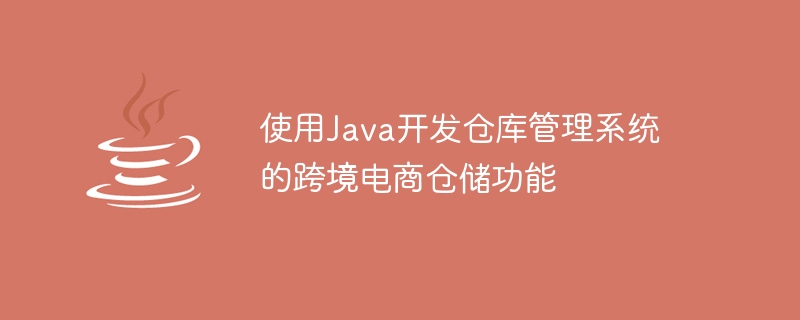Home >Java >javaTutorial >Using Java to develop the cross-border e-commerce warehousing function of the warehouse management system
Using Java to develop the cross-border e-commerce warehousing function of the warehouse management system
- WBOYWBOYWBOYWBOYWBOYWBOYWBOYWBOYWBOYWBOYWBOYWBOYWBOriginal
- 2023-09-25 12:39:181742browse

Title: Java warehouse management system development for cross-border e-commerce warehousing function
Introduction:
With the continuous development of e-commerce and the trend of globalization, The cross-border e-commerce industry is booming. Warehousing management is an indispensable part of cross-border e-commerce operations. This article will introduce how to use Java to develop a warehouse management system to help cross-border e-commerce achieve efficient warehousing functions. At the same time, some specific code examples will be attached so that readers can better understand and practice.
- System Requirements Analysis
Before developing the warehouse management system, we need to first understand the warehousing needs of cross-border e-commerce. Common warehouse management functions include inventory management, inbound and outbound management, inventory and reports, etc. In order to improve operational efficiency, we can also add some auxiliary functions, such as barcode management, automatic sorting, and location management. - Database Design
The core of the warehouse management system is the storage and management of data. We can use a relational database, such as MySQL, to store warehouse-related data. Design inventory tables, inbound tables, outbound tables, etc., and define fields according to specific needs. The following is a simple warehouse table design example:
CREATE TABLE warehouse (
id int(11) NOT NULL AUTO_INCREMENT,
name varchar(50) NOT NULL,
location varchar(100) NOT NULL,
capacity int(11) NOT NULL,
PRIMARY KEY (id)
) ENGINE=InnoDB DEFAULT CHARSET=utf8;
- User Interface Design
In order to provide a friendly warehouse management experience, we need to design A user interface. You can use Java's GUI library to implement interface design, such as Swing or JavaFX. Design a warehouse management main interface, including menu bar, toolbar and warehouse information display area. By clicking on the menu or toolbar, users can quickly operate warehouse management-related functions. - Business logic implementation
4.1 Inventory management
Inventory management is one of the core functions of the warehouse management system. We need to provide the functionality to increase inventory, decrease inventory, and query inventory. The following is a Java code example:
// Increase inventory
public void addInventory(int productId, int quantity) {
// 根据产品ID查询库存
Inventory inventory = inventoryDao.getByProductId(productId);
if (inventory == null) {
// 如果库存不存在,则新建库存
inventory = new Inventory();
inventory.setProductId(productId);
inventory.setQuantity(quantity);
inventoryDao.save(inventory);
} else {
// 如果库存已存在,则增加数量
inventory.setQuantity(inventory.getQuantity() + quantity);
inventoryDao.update(inventory);
}}
// Reduce Inventory
public void reduceInventory(int productId, int quantity) {
// 根据产品ID查询库存
Inventory inventory = inventoryDao.getByProductId(productId);
if (inventory != null) {
// 如果库存存在,则减少数量
inventory.setQuantity(inventory.getQuantity() - quantity);
inventoryDao.update(inventory);
}}
// Query inventory
public int getInventory(int productId) {
// 根据产品ID查询库存
Inventory inventory = inventoryDao.getByProductId(productId);
if (inventory != null) {
return inventory.getQuantity();
}
return 0;}
4.2 Inbound and outbound management
Inbound and outbound management is the basic operation of the warehouse management system. We need to design the corresponding interfaces and interfaces, and implement relevant business logic. The following is a Java code example for inbound and outbound management:
//Inbound
public void inBound(int productId, int quantity) {
// 根据产品ID查询库存
Inventory inventory = inventoryDao.getByProductId(productId);
if (inventory != null) {
// 更新库存数量
inventory.setQuantity(inventory.getQuantity() + quantity);
inventoryDao.update(inventory);
// 记录入库记录
InBoundRecord record = new InBoundRecord();
record.setProductId(productId);
record.setQuantity(quantity);
record.setTime(new Date());
inBoundDao.save(record);
}}
//Outbound
public void outBound(int productId, int quantity) {
// 根据产品ID查询库存
Inventory inventory = inventoryDao.getByProductId(productId);
if (inventory != null && inventory.getQuantity() >= quantity) {
// 更新库存数量
inventory.setQuantity(inventory.getQuantity() - quantity);
inventoryDao.update(inventory);
// 记录出库记录
OutBoundRecord record = new OutBoundRecord();
record.setProductId(productId);
record.setQuantity(quantity);
record.setTime(new Date());
outBoundDao.save(record);
}}
- Other function implementation
In addition to inventory management, warehousing and outbound In addition to library management functions, we can also implement some auxiliary functions, such as barcode management, automatic sorting, and location management. The implementation of these functions depends on specific needs and can be implemented using Java related technologies and libraries.
Conclusion:
This article introduces the basic steps and implementation methods of using Java to develop a cross-border e-commerce warehouse management system. Through the development of core functions such as inventory management, warehousing and outbound management, cross-border e-commerce can be helped to achieve efficient warehousing functions. Readers can expand and optimize according to actual conditions, and refer to code examples for development and practice. The development of a warehouse management system is a complex task that requires comprehensive consideration of business requirements, data storage, and user interface. I hope this article can provide readers with some guidance and inspiration.
The above is the detailed content of Using Java to develop the cross-border e-commerce warehousing function of the warehouse management system. For more information, please follow other related articles on the PHP Chinese website!
Related articles
See more- What does % mean in Java?
- How to create a java project in idea
- Automatic warehousing and abnormal order processing strategies for Java warehouse management system
- Warehouse leasing and warehouse sharing functions of Java warehouse management system
- Storage location planning and inventory optimization algorithm for Java warehouse management system

